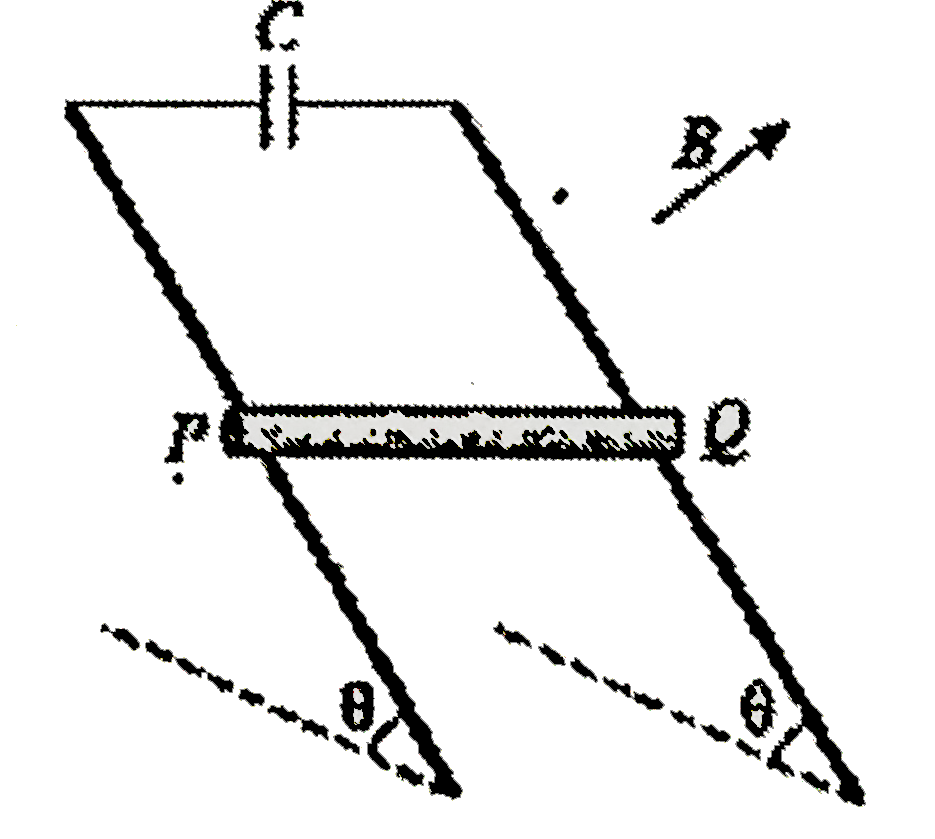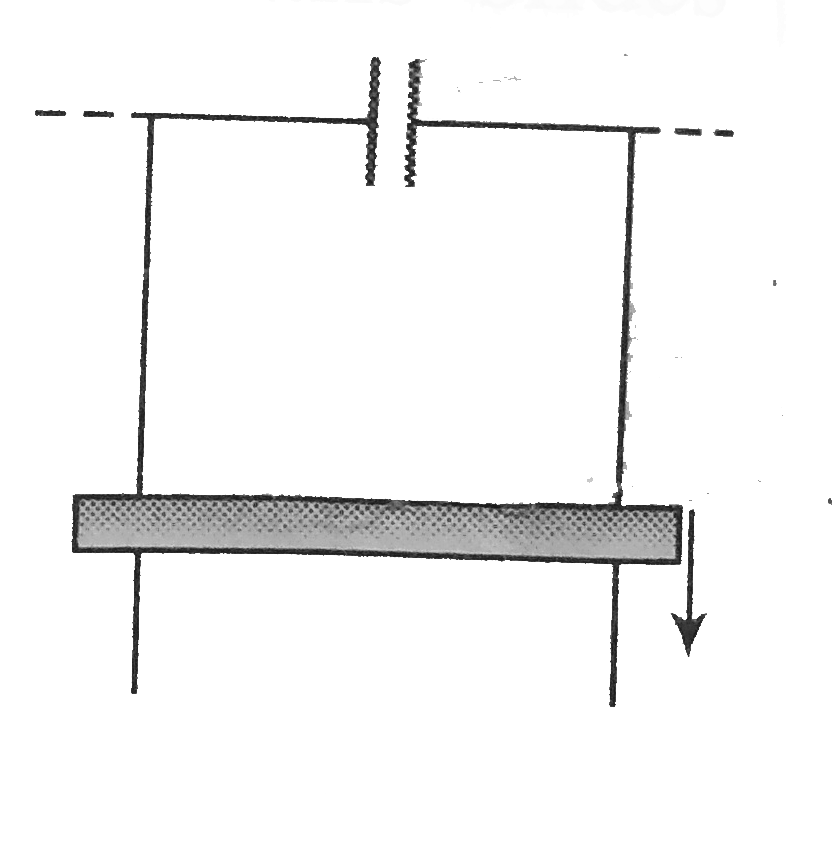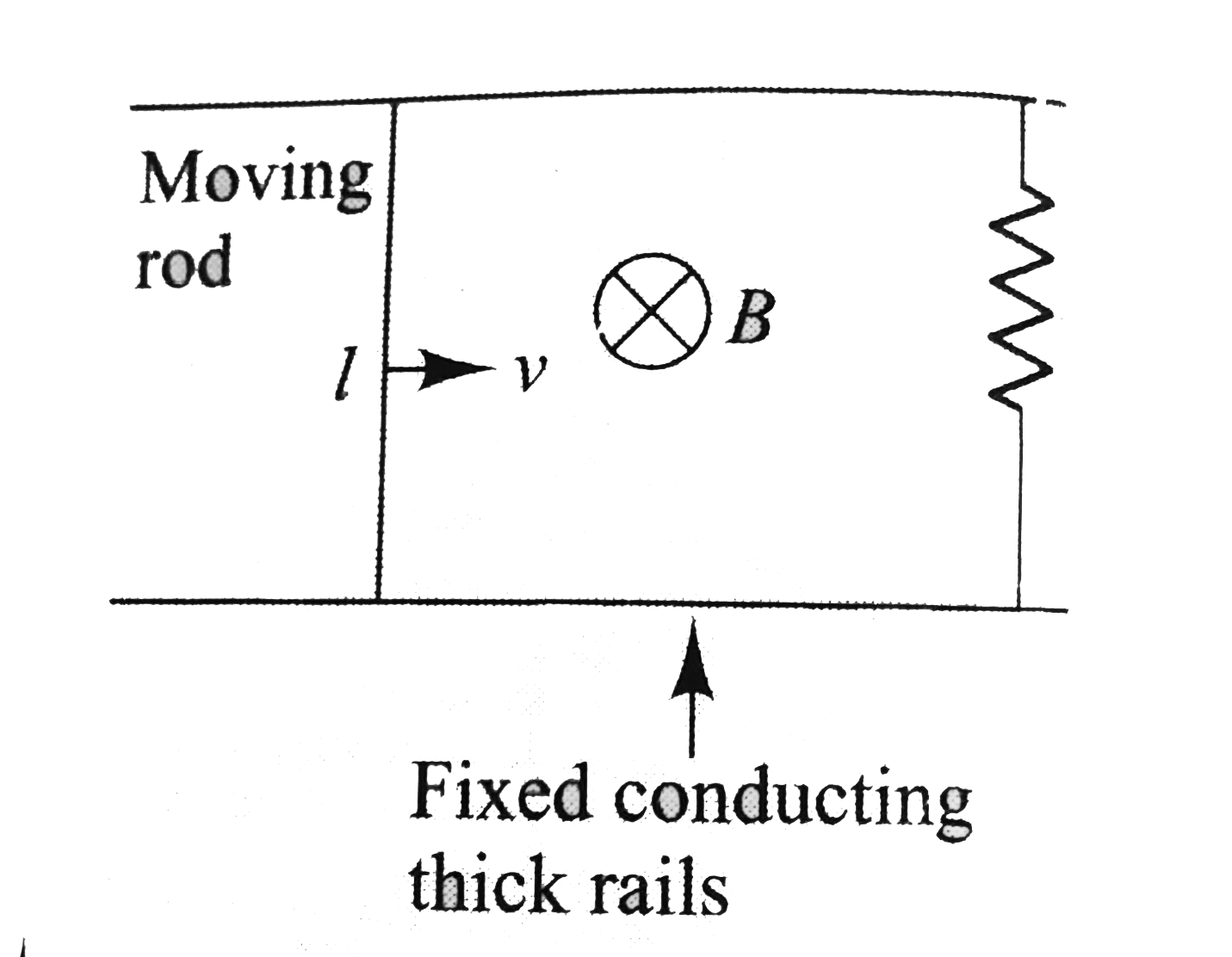Two vertical metal rails are connected at the top through a capacitor of capacitance C. Uniform magnetic field →B is applied perpendicular to the plane of rails as shown in figure. Another metal rod of mass m can freely slide on this pair of frictionless rails. This metal rod starts falling down due to gravity. Separation between the rails is l. What will be the acceleration of rod? All resistances are negligible.

When rod acquires downward velocity v, then motional emf is generated across its length Magnitude of motional emf can be written as follows:
ε=Blv
End Q of the rod acquires positive potential and current starts flowing as shown in figure. Capacitor gets charged but its charge changes according to motional emf.

Let instantaneous charge stored in the capacitor be q then we can write the following:
q = CE = CBvl
Current flowing in the loop can Z be written as follows:
i=dqdt=CBldvdt
i=CBla ...(i)
Here .a. is acceleration of rod.
Current in the rod flows from end P to Q and corresponding magnetic force is acting upward as shown in the figure. Gravity (mg) and magnetic force (ilB) are the two forces acting on rod as shown in figure. We can write equation of motion as follows:
mg - ilB = ma
Substituting current from equation (i) in the above equation, we get the following:
mg = (CBla)lB = ma
⇒mg=CB2l2a+ma
⇒a=mgCB2l2+m
Topper's Solved these Questions
- ELECTROMAGNETIC INDUCTIONBOOK - MODERN PUBLICATIONCHAPTER - ELECTROMAGNETIC INDUCTIONEXERCISE - REVISION EXERCISE (Very Short Answer Questions Carrying I mark)
44 Videos
- ELECTROMAGNETIC INDUCTIONBOOK - MODERN PUBLICATIONCHAPTER - ELECTROMAGNETIC INDUCTIONEXERCISE - REVISION EXERCISE (Additional Questions (Carrying I mark))
11 Videos
- ELECTROMAGNETIC INDUCTIONBOOK - MODERN PUBLICATIONCHAPTER - ELECTROMAGNETIC INDUCTIONEXERCISE - NCERT FILE (NCERT EXEMPLAR PROBLEMS SUBJECTIVE QUESTIONS) (Short answer type questions)
5 Videos
- ELECTRIC CHARGES AND FIELDS BOOK - MODERN PUBLICATIONCHAPTER - ELECTRIC CHARGES AND FIELDS EXERCISE - Chapter Practice Test
15 Videos
- ELECTROMAGNETIC WAVESBOOK - MODERN PUBLICATIONCHAPTER - ELECTROMAGNETIC WAVESEXERCISE - CHAPTER PRACTICE TEST
14 Videos
Similar Questions
There are two metal vertical rails connected to a capacitor of capacitance 10 mF as shown in figure. Magnetic field strength of 1 T is applied perpendicular to theplaneofrails. Separation between the rails is 10 cm. Ratio of current flowing through the loop and acceleration of the rod is found to be nx10−3 in MKS system. Find the value of n.
View SolutionA straight horizontal conductor PQ of length l, and mass_ m slides down on two smooth conducting fixed parallel rails, set inclined at an angle 9 to the horizontal as shown in figure-5.30.
 The top end of the bar are connected with a capacitor of capacitance C. The system is placed in a uniform magnetic field, in the direction perpendicular to the inclined plane formed by the rails as shown in figure. If the resistance of the bars and the sliding conductor are negligible calculate the acceleration of sliding conductor as a function of time ifit is released from rest at t= 0
The top end of the bar are connected with a capacitor of capacitance C. The system is placed in a uniform magnetic field, in the direction perpendicular to the inclined plane formed by the rails as shown in figure. If the resistance of the bars and the sliding conductor are negligible calculate the acceleration of sliding conductor as a function of time ifit is released from rest at t= 0
View Solution
Knowledge Check
A conducting rod of length is moved at constant velocity v0 on two parallel, conducting, smooth, fixed rails, that are placed in a uniform constant magnetic field B perpendicular to the plane for the rails as shown in Fig. A resistance R is connected between the two ends of the rails.
Then which of the following is/are correct:
 ATh thermal power dissipated in the resistor is equal to rate of work done by externl person pulling the rod.BIf applied external force is doubled then a part of external power increases the velocity of rod.CLenz's Law is not satisfied if the rod is accelerated by external forceDIf resistance R is doubled then power required to maintain the constant velocity v0 becomes half.
ATh thermal power dissipated in the resistor is equal to rate of work done by externl person pulling the rod.BIf applied external force is doubled then a part of external power increases the velocity of rod.CLenz's Law is not satisfied if the rod is accelerated by external forceDIf resistance R is doubled then power required to maintain the constant velocity v0 becomes half.Two long rails are hporizontal and parallel to each. On one end, the rails are connected by a resistance R and on the other end a cpacitor of capacitance C is connected as shown in the figure . A connecter of mass m and length l can slide on the rails without friction. Uniform magnetic field B, perpendicular to he plane of hte gigure exists in space. A constant horizontal force F starts acting on hte connector. What is the acceleration of connector when its veleocity is 34 of its terminal velocity?
 A3F4(m+CB2I2)BF(m+CB2I2)CF4(m+CB2I2)D4F3(m+CB2I2)
A3F4(m+CB2I2)BF(m+CB2I2)CF4(m+CB2I2)D4F3(m+CB2I2)Two vertical conducting rails separted by distance 1.0m are placed parallel to z-axis as shown in figure. At z=0, a capacitor of 0.15F is connected between the rails and a metal rod of mass 100g placed across the rails slides down along the rails. if a constant magnetic fields of 2.0 T exists perpendicular to the plane of the rails, what is the acceleration of the rod?
 A2.5m/s2BzeroC9.8m/s2)D1.4m/s2)
A2.5m/s2BzeroC9.8m/s2)D1.4m/s2)
Shows a rod of length l and resistance r moving on two rails shorted by a resistance R. A uniform magnetic field B is present normal to the plane of rod and rails. Show the electrical equivalence of each branch.

View SolutionShows a rod of length l and resistance r moving on two rails shorted by a resistance R. A uniform magnetic field B is present normal to the plane of rod and rails. Show the electrical equivalence of each branch.

View SolutionShows a rod of length l and resistance r moving on two rails shorted by a resistance R. A uniform magnetic field B is present normal to the plane of rod and rails. Show the electrical equivalence of each branch.

View SolutionA conducting rod of length is moved at constant velocity v0 on two parallel, conducting, smooth, fixed rails, that are placed in a uniform constant magnetic field B perpendicular to the plane for the rails as shown in Fig. A resistance R is connected between the two ends of the rails.
Then which of the following is/are correct:

View SolutionA conducting rod of length is moved at constant velocity v0 on two parallel, conducting, smooth, fixed rails, that are placed in a uniform constant magnetic field B perpendicular to the plane for the rails as shown in Fig. A resistance R is connected between the two ends of the rails.
Then which of the following is/are correct:

View Solution
